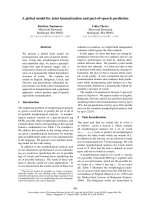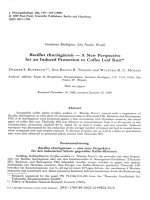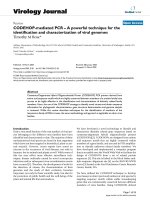A new technique for adapting sip protocol to Ad hoc networks: VNSIP ((Virtual Network for SIP) illustration and evaluation of performance
Bạn đang xem bản rút gọn của tài liệu. Xem và tải ngay bản đầy đủ của tài liệu tại đây (1.7 MB, 7 trang )
International Journal of Computer Networks and Communications Security
C
VOL. 1, NO. 1, JUNE 2013, 23–29
Available online at: www.ijcncs.org
ISSN 2308-9830
N
C
S
A New Technique for Adapting SIP Protocol to Ad Hoc Networks:
VNSIP (Virtual Network for SIP) Illustration and Evaluation of
Performance
I. Mourtaji1, M. Bouhorma2, M. Benahmed3, A. Bouhdir4
1234
LIST laboratory, FST of Tangier, Morroco
E-mail: , , ,
4
ABSTRACT
Ad Hoc Networks provide a real opportunity to design flexible networks, very simple to deploy. However
they remain a particular computation environment, characterized by the deficiency of pre-existed and
centralized infrastructure. In the other hand, SIP protocol, which knows a huge booming in internet
networks, requires centralized entities, like proxy server, registrar server and location service; consequently
SIP is not adapted to Ad Hoc networks. In this paper, we present and evaluate a new technique, which we
have called Virtual Network for SIP (VNSIP) to fix the problem related to the constraints of SIP
deployment in Ad Hoc network. The main idea of this technique is to create a virtual infrastructure,
enabling SIP to proceed in a distributed architecture inside the Ad hoc Network.
Keywords: Ad hoc, SIP, Evaluation of performance
1
INTRODUCTION
Using this technique, we will be able to design a
virtual sub-network, which will be used by SIP [1,
2, 10] in a high mobility Ad Hoc network.
VNSIP allows decentralization of SIP proxies,
specially registrar, proxy and location servers, by
integrating those server functionalities in each
MANET node. VNSIP node contains a supervisor
module which we called Virtual Network
Algorithm (VNA), and which is responsible of
activating and deactivating server functionalities
depending on the position of the node in the
MANET [3].
This paper is organized as follows. In the first
section we’ll introduce VNSIP solution. In the
second section we’ll illustrate VNSIP design.
Afterward in the next section, we’ll present TCA
solution. In the last section we will evaluate VNSIP
performance using comparison with TCA approach.
In the end, we will achieve this paper with a
conclusion, with future works and perspectives.
2
VNSIP SOLUTION PRESENTATION
The presence of Proxy Server, Registrar Server
and Location Service is a prerequisite for SIP
operations. Thus it’s necessary to decentralize those
servers to enabling SIP integration in Ad Hoc netw
The most evident solution, to fix this problem, is to
include all SIP servers’ functionalities in each node
of the ad hoc network [4, 5]. However this solution
consumes a lot of energy when broadcasting
messages to find a node location [6], and generates
many failure connections because of message
collisions. Making this solution not optimal.
VNSIP solution tries to define a dynamic virtual
network inside the MANET, to be exploited by
nodes, to adequately choose which one will be in
charge to execute SIP server tasks. VNA (Virtual
Network Algorithm) will be the entity in charge to
activate or deactivate SIP server functionalities in
each MANET node. A VNSIP node (see Figure 1)
consists of several entities, when interacting
between them; they allow communication in
MANET using SIP protocol.
24
I Mourtaji et al. / International Journal of Computer Networks and Communications Security, 1 (1), JUNE 2013
Fig. 2. Generation of nodes belonging to the VN
Fig. 1. VNSIP Node Architecture
3
VNSIP DESIGN
The first step is the construction of the Virtual
Network (VN), which will be used by VNSIP to
affect SIP server functionalities to the different
nodes.
3.1
To complete the construction of a connected VN,
we define Gateway nodes to ensure connections
between all nodes belonging to the VN. Gateways
are generated using the execution of the two rules
below:
Rule 1: if two nodes belonging to the VN,
and don’t have a connection between them,
and have a same neighbor node which
doesn’t belong to the VN, then this node is
considered as a Gateway.
Rule 2: if two neighbor nodes, which don't
belong to the VN, and there neighbors are
respectively belonging to the VN, then
those two nodes are considered as
Gateways.
When finishing the selection of gateway
nodes the construction of the VN is
completed (see Figure 3).
Virtual Network Algorithm (VNA)
VNA starts by the construction of neighbor tables.
Thus each node of the MANET broadcasts a
HELLO message [7]. When receiving this message
for the first time, each node can populate its own
neighbors table with its 1-hop neighbor’s number
information.
HELLO message is then sent for a second time,
including
the
1-hop
neighbor’s
number
information. When receiving the second HELLO
message, each node upgrades its neighbors table
with its 1-hop neighbor’s number and 2-hop
neighbors number information.
VNA defines a flag “VN_membership_flag”
which shows if a node belongs to the VN or not.
When executing VNA, the VN will include all
nodes having VN_membership_flag=1. VNA is
characteri-zed by two conditions (see Figure 2):
Condition1: if a node doesn’t belong to the
VN and the number of its neighbors which
belong to the VN is lower than the number
of its neighbors which don’t belong to the
VN then the VN_membership_flag of this
node is set to 1.
Condition 2: if a node belongs to the VN
and the number of its neighbors which
belong to the VN is higher than the number
of its neighbors which don’t belong to the
VN then the VN_membership_flag of this
node is set to 0.
Fig. 3. VN construction
25
I Mourtaji et al. / International Journal of Computer Networks and Communications Security, 1 (1), JUNE 2013
3.2
Interaction between VNA and SIP
entities
As it shown in Figure 3, when finishing the
construction of the VN, three kinds of nodes are
defined:
- If a node belongs to the VN, then it plays SIP
User Agent role and all its SIP server’s
functionalities (Proxy server (PS), Registrar (RG)
and location service (LS)) are activated,
- If a node is a gateway, then it plays SIP User
Agent role and PS role. RG and LS are deactivated.
- If a node doesn’t belong to the VN, then it plays
only SIP User Agent role and its SIP server’s
functionalities are deactivated.
3.3
Implementation of SIP Operations
Fig. 5. Registration for a node don't belonging to the
VN
Registration:
When a node of the ad hoc network decides to
registrar to the SIP network generated by VNSIP,
two possibilities are treated:
The node belongs to the VN: in this case,
SIP servers for this node are activated.
Thus its User Agent sends a Registrar
message to its own RG, making a local
registration (see Figure 4).
Session Initiation:
When a node A decides to initiate a session with
a node B. if SIP servers of A are activated then it
sends INVITE message directly to its own PS (see
Figure 6). Or if its SIP servers are deactivated, in
this case, it broadcasts the INVITE to its 1-hop
neighbors (see Figure 7).
When a PS receives the INVITE, it sends a
request to its LS to verify in the data base if he
knows the route to B. if it does then the PS redirects
the INVITE directly to B (see Figure 6). If not, it
broadcast the INVITE to its 1-hop neighbors (see
Figure 7).
When the User Agent of B receives the INVITE,
its answers by a 200 OK message, which will
follow the reverse path of the INVITE.
Fig. 4. Registration for a node belonging to the VN
The node doesn’t belong to the VN: in this case,
the User Agent of this node broadcasts a Register
message to all its 1-hop neighbors, each neighbor
register this node to its own RS if it belong to the
VN (see Figure 5).
Fig. 6. PS of Node A knows location of Node B
26
I Mourtaji et al. / International Journal of Computer Networks and Communications Security, 1 (1), JUNE 2013
Fig. 8. TCA Node architecture
SIP UA module: realizes UAC and UAS
functions, it initiates and responses to SIP requests.
SIP Servers module: represents the different SIP
servers (LS, RG and PS).
Fig. 7. PS of Node C doesn't know location of Node B
4
TCA APPROACH
In this chapter we will describe the design of
TCA solution [9], to be compared with our solution
VNSIP. TCA approach has been chosen because of
its good results and because of its similarity with
VNSIP.
4.1
SIP terminal presentation in TCA
Topo module: constructs a cluster topology to be
used by the different SIP modules.
4.2
TCA Operating System
TCA solution is essentially based on topology
construction module, which is inspired by
clustering approach. In fact, the topology
construction algorithm chooses nodes to ensure
cluster-head role. Nodes which not considered as
cluster-heads will be considered as cluster
members. Clusters will be related between them
using gateway nodes (see Figure 9).
For TCA approach, each node of the ad hoc
network should be able to guarantee the
functionalities below:
SIP User Agent Client (UAC),
SIP User Agent Server (UAS),
SIP Proxy Server (PS),
SIP Registrar (RG),
SIP Location Server (LS),
Topology construction
To achieve those functions, many models have
been integrated in the same terminal; Figure 8
illustrates SIP node composition and interaction
between those nodes.
Fig. 9. Cluster construction
27
I Mourtaji et al. / International Journal of Computer Networks and Communications Security, 1 (1), JUNE 2013
When topology construction is achieved, the topo
module assigns to each SIP module its role in the
network. Each node is considered as a simple User
Agent and according to its position in the network;
additional tasks may be attributed to this node:
A node which is considered as clusterhead will guarantee, in addition to UA
role, PS, RG and LS role.
A node which is cluster member and
gateway node will guarantee, in addition
to UA role, PS role.
A node which is only considered as cluster
member will guarantee a simple UA role
.
SIMULATIONS AND EVALUATION
OF PERFORMANCES
5
5.1
After analyzing the graph above, we can note that
our approach guarantees a better time, than TCA
solution, to establish sessions between nodes. We
can justify this behavior by the fact that our
solution VNSIP uses, to forward SIP messages, a
higher number of nodes than TCA. And we can add
that, replication mechanism used by VNSIP, allows
performing many research on different SIP proxies
on the same time, which helps to receive responses
on shortest time.
The figure 11 illustrates session setting time, from
TCA and VNSIP, according to the number of nodes
Configuration
Simulations scenarios were achieved using the
network simulator NS2 [8]. The simulation area
was 1000m by 1000m. The node number was
between 10 and 50 nodes. The movement speed of
nodes was between 0 and 18 m/s, and times of
simulations were 180 seconds.
5.2
Scenarios of simulations
To define the difference between VNSIP behavior
and TCA behavior, we achieved many types of
simulations, and we analyzed the behaviors when
node speeds and node numbers are increased.
5.2.1
Session setting time
The figure 10 illustrates session setting time, from
TCA and VNSI, according to nodes mobility.
Fig. 11. Session setting time according to number of
nodes
Comparing curves above, we observe that VNSIP
gives better performance than TCA. In fact when
the number of nodes, which are in charge to
forward SIP messages, is increasing, it directly
involves that session setting time decreased. Unlike
TCA mechanism, which uses only one cluster-head
to manage cluster members by forwarding SIP
messages,
generating
largest
queue
and
consequently the session setting time is increased.
5.2.2
Failure rates
The figure 12 illustrates the failure rates of session
setting according to nodes mobility for TCA and
VNSIP methods.
Fig. 10. Session setting time according to mobility
28
I Mourtaji et al. / International Journal of Computer Networks and Communications Security, 1 (1), JUNE 2013
When we compare both graphs, we note that
VNSIP gives lower results than TCA; in fact
consumption of bandwidth is higher and increases
when number of nodes is rising. This behaviour can
be warranted by the high number of message sent
when applying our replication mechanism, which
consists of achieving several registration and
localization in the same time for the same node.
6.
Fig. 12. Failure rates by mobility of nodes
When we compare failure rates to establish SIP
sessions between both methods, we observe that
VNSIP performs better results in terms of
successful sessions setting. This result can be easily
justified by the difference between VNSIP and
TCA architectures. VNSIP uses replication
mechanism, which allows forwarding SIP messages
by several nodes, unlike TCA which uses only
cluster-heads to forward SIP messages, this
involves that there is only one registration for each
node. Therefore TCA mechanism is very sensitive
and vulnerable to cluster-heads moves.
5.2.3
Bandwidth consumption
The figure 13 illustrates bandwidth consumption
when establishing SIP sessions according to
number of nodes.
Fig. 13. Bandwidth consumption by number of nodes
CONCLUSION
In this paper we have analyzed and evaluated the
performance of a new approach for adapting SIP
protocol to Ad Hoc Networks. To achieve this
evaluation of performance, we have compared our
solution to the TCA approach, which is consider as
a solution giving a very interesting result to fix the
problem of SIP adaptation to Ad Hoc Networks.
The simulation of both approaches has shown
that our solution guarantees better results than
TCA in terms of setting time and failure rates of
SIP sessions. These good results were obtained
thanks to VNA, the algorithm used to construct the
VNSIP topology, and thanks to the mechanism of
replication of SIP messages. On the other side, this
mechanism has its own disadvantage, which
involve that our solution proposes lower results
than TCA in term of bandwidth consumption.
For our future works, we’ll try to improve our
solution to reduce the consumption of bandwidth.
Actually we are designing a new algorithm, to
guarantee a good MANET QoS.
7.
REFERENCES
[1] J. Westcott et G. Lauer, ‘Hierarchical routing
for very large networks’, Proc. IEEE MILCOM
’84, pp 214-218, 21-24 October 1984.
[2] J. Rosenberg, H. Schulzrinne, G. Camarillo, A.
Johnston, J. Peterson, R. Sparks, M. Handeley
et E. Schooler, “SIP: Session Initiation
Protocol”, RFC 3261, Juin 2002.
[3] S. Corson, J. Macker, ‘Mobile Ad hoc
Networking (MANET): Routing Protocol
Performance
Issues
and
Evaluation
Considerations’, REC 2501, Janvier 1999.
[4] M. Jiang, J. Li and Y. C. Tay, “Cluster Based
Routing Protocol (CBRP),” IETF Internet
Draft draft-ietf-manet-cbrp-spec-01.txt, August
1999.
[5] C. R. Lin and M. Gerla, “Adaptive clustering
for mobile, wireless networks,” Journal on
Selected Areas of Communication, Vol. 15,
No. 7, 1997.
29
I Mourtaji et al. / International Journal of Computer Networks and Communications Security, 1 (1), JUNE 2013
[6] J. Rosenberg and H. Schulzrinne, “SIP:
Locating SIP Servers”, IETF RFC 3263, June
2002.
[7] C. Perkins, E. Belding-Royer, and S. Das “ Ad
hoc On-Demand Distance Vector (AODV)
Routing ”, IETF RFC 3561, July 2003.
[8] “The network simulator”, available at
/>[9] N. Banerjee, A. Acharya and S.K. Das,
“Enabling SIP-Based Sessions in Ad Hoc
Networks “, Winet, April 2006.
[10] A.B. Roach, “Session Initiation Protocol (SIP)
– Specific Event Notification”, RFC 3265, Juin
2002.
[11] P. Stuedi, M. Bihr, A. Remund et G. Alonso, «
Siphoc : Efficient sip middleware for ad hoc
networks » studi2007siphoc, LECTURE
NOTES IN COMPUTER SCIENCE, 2007,
Springer
[12] S. Leggio, J. Manner, A. Hulkkonen, et K.
Raatikainen, “Session initiation protocol
deployment in ad hoc networks: a
decentralized approach”, In 2nd International
Workshop on Wireless Ad-hoc Networks
(IWWAN), London, May, 2005.









